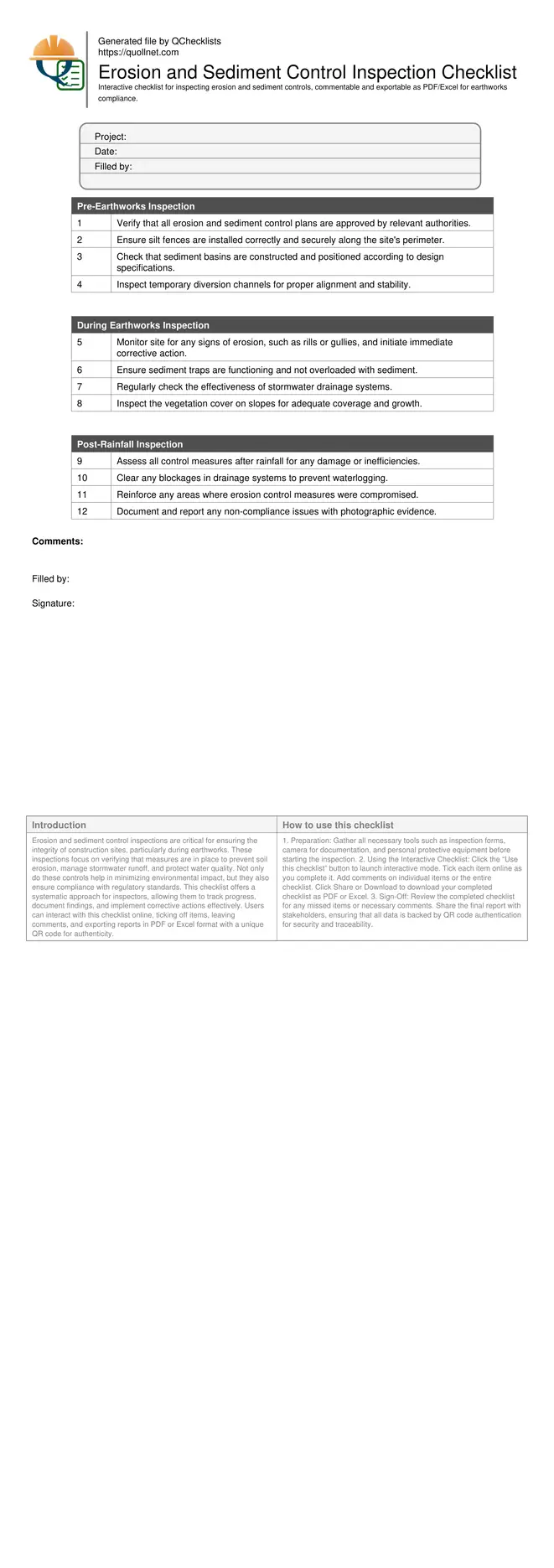Erosion and Sediment Control Inspection
Erosion and sediment control inspections are critical for ensuring the integrity of construction sites, particularly during earthworks. These inspections focus on verifying that measures are in place to prevent soil erosion, manage stormwater runoff, and protect water quality. Not only do these controls help in minimizing environmental impact, but they also ensure compliance with regulatory standards. This checklist offers a systematic approach for inspectors, allowing them to track progress, document findings, and implement corrective actions effectively. Users can interact with this checklist online, ticking off items, leaving comments, and exporting reports in PDF or Excel format with a unique QR code for authenticity.
- Ensure compliance with environmental regulations through systematic inspections.
- Prevent soil erosion and manage stormwater runoff effectively on construction sites.
- Interactive online checklist with tick, comment, and export features secured by QR code.
- Enhance site safety and environmental protection by adhering to best practices.
Pre-Earthworks Inspection
During Earthworks Inspection
Post-Rainfall Inspection
Understanding Erosion and Sediment Controls
Erosion and sediment controls are essential practices used on construction sites to prevent soil erosion and manage stormwater runoff. These measures are designed to minimize environmental impact by controlling the movement of soil and water. Effective erosion and sediment control plans include a variety of techniques and structures such as silt fences, sediment basins, and diversion channels.
- Silt fences should be properly trenched and secured.
- Sediment basins must be regularly maintained.
- Diversion channels should be stable and correctly aligned.
- Effective implementation reduces environmental degradation.
Best Practices for Inspection
Conducting thorough inspections before, during, and after earthworks is crucial. Pre-earthworks inspections ensure all plans and measures are in place, while ongoing inspections during earthworks monitor the site's conditions. Post-rainfall inspections are vital to address any issues that arise due to weather conditions.
- Pre-earthworks inspections verify initial setup.
- Ongoing inspections detect issues early.
- Post-rainfall checks assess damage and efficiency.
- Documentation and reporting aid compliance.
How to Use This Checklist
- Preparation: Gather all necessary tools such as inspection forms, camera for documentation, and personal protective equipment before starting the inspection.
- Using the Interactive Checklist: Click the “Use this checklist” button to launch interactive mode. Tick each item online as you complete it. Add comments on individual items or the entire checklist. Click Share or Download to download your completed checklist as PDF or Excel.
- Sign-Off: Review the completed checklist for any missed items or necessary comments. Share the final report with stakeholders, ensuring that all data is backed by QR code authentication for security and traceability.
Call to Action
- Start Checklist Tick off tasks, leave comments on items or the whole form, and export your completed report to PDF or Excel—with a built-in QR code for authenticity.
- Download Excel - Erosion and Sediment Control Inspection
- Download PDF - Erosion and Sediment Control Inspection
- View Image - Erosion and Sediment Control Inspection
